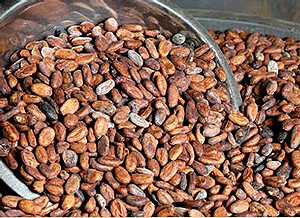

The Scharffen Berger logo features an ibex mountain goat and three stars. All photography by Saidi Granados.
|
PETER ROT is the THE NIBBLE’s chocolate specialist.
|
September 2008
|
 |
Scharffen Berger Chocolate
Page 5: Scharffen Berger Chocolate Style
This is Page 5 of a six-page article. Click on the black links below to visit other pages.
Scharffen Berger Chocolate Style
A maker must roast each type of bean to reach a specific flavor profile and then blend each type to create a specific, finished flavor.
Roasting
One property that distinguishes Scharffen Berger from other quality producers is its roasting style.
Many makers rely on roasting to add flavor and character to their chocolate, which can, in a sense, distract from the flavor of the beans. While most makers roast their beans for a longer time or at a higher temperature to achieve their desired balance in the finished chocolate, Scharffen Berger tends to be more conservative with its roasting. This means that each product—regardless of blend—will have a lighter flavor, usually fruity, and will not be too heavy or bold in the mouth (such as Pralus, who favors an extremely dark roast, to the point where his chocolate can be likened to espresso in terms of intensity and boldness), or balanced and varied (such as Michel Cluizel). With a Scharffen Berger bar, you get a slightly brighter, more realistic portrayal of the beans’ characteristics.
Such a stylistic preference can actually help to preserve certain traits and flavors that darker roasting can often hide. As a result, the types of cacao that Scharffen Berger chooses must be extra top quality, because any irregularity in the beans may show up in the chocolate. Although blending can provide some cushioning against this danger, in some cases it might not be enough.
- For example, if a certain type of cacao is used in too great a proportion, or if its intensity is too strong for the other cacaos in the blend, then the chocolate maker must balance out these characteristics by blending in other types of cacao.
- Likewise, if a type of cacao is too fruity and dominates the blend, its ratio must be adjusted in accordance to the other cacao varieties in the blend.
Blending
Equally important is blending. Unlike most quality chocolate makers that produce selections of both origin and blended bars, Scharffen Berger’s line is almost exclusively blends, with the occasional origin cacao appearing as a Limited Series bar.
 Luckily, beans are chosen based on their individual properties, so fruitiness may only need to be present in one type of cacao and deep chocolatey undertones in another. Blending the varieties, then, may seem to be just a matter of figuring out ratios. But it’s art as much as science, and sometimes a maker must roast one of the constituent cacaos all over again, or in some cases, start a new “recipe” from scratch. Luckily, beans are chosen based on their individual properties, so fruitiness may only need to be present in one type of cacao and deep chocolatey undertones in another. Blending the varieties, then, may seem to be just a matter of figuring out ratios. But it’s art as much as science, and sometimes a maker must roast one of the constituent cacaos all over again, or in some cases, start a new “recipe” from scratch.
Photo: Roasted cacao beans at Scharffen Berger.
While blending is an art, so is finding the right beans and perfect balance of processing techniques to present an origin cacao. With origin cacao, there are more variables that affect flavor; more things can go wrong, so it’s crucial to have tight control every step of the way. It’s extremely challenging—not to mention time consuming—especially when each batch of beans must be processed separately.
Continue To Page 6: Review Of Scharffen Berger Bars
Go To Article Index Above
Lifestyle Direct, Inc. All rights reserved. Images are the copyright of their respective owners.

|





 Luckily, beans are chosen based on their individual properties, so fruitiness may only need to be present in one type of cacao and deep chocolatey undertones in another. Blending the varieties, then, may seem to be just a matter of figuring out ratios. But it’s art as much as science, and sometimes a maker must roast one of the constituent cacaos all over again, or in some cases, start a new “recipe” from scratch.
Luckily, beans are chosen based on their individual properties, so fruitiness may only need to be present in one type of cacao and deep chocolatey undertones in another. Blending the varieties, then, may seem to be just a matter of figuring out ratios. But it’s art as much as science, and sometimes a maker must roast one of the constituent cacaos all over again, or in some cases, start a new “recipe” from scratch.